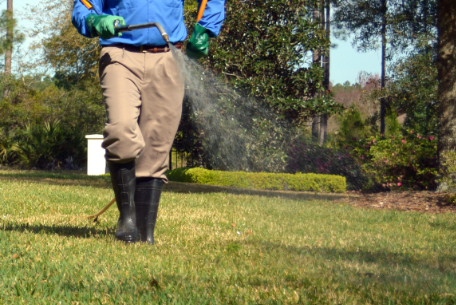Insect & Lawn Disease Control
Prevention or early detection of pests and lawn disease is the best way to avoid damage, wasted time, and more money spent. If you suspect insect infestation or lawn disease, don’t hesitate to give us a call at 478-992-5705. We also offer flea and tick treatments for your lawn to protect your pets and make your lawn more enjoyable.
Insect Control
We are proud to offer specialized programs for controlling turf eating insects that love to destroy your lawn. Here are a few of the typical insects that plague Middle Georgia lawns:
Chinch Bugs
Chinch bugs appear in St. Augustine grasses between the warm summer months of July to October. These insects grow to be about one-eighth of an inch long and have reddish coloring until they reach maturity. Chinch bugs cause individual blades of grass to turn yellow, and shortly after, a large section of turf will turn brown. Chinch bugs cause serious damage to St. Augustine lawns, so if you suspect them, it’s important to call Mid Georgia Turf Solutions as soon as possible.
Spittlebugs
While spittlebugs can be found feeding on most warm season grasses like St. Augustine, Bermuda, and Zoysia, these small, black insects prefer centipede grasses. Spittlebugs are easily recognized by the two horizontal, red lines spanning the width of their tent-shaped bodies. The nymphs, or baby spittlebugs, produce a goo-like spittle which serves to protect them from predators and maintain the moist environment they need to survive. With needle-like mouth parts, spittlebugs suck the fluid out of turf while injecting a toxin that causes it to wither and turn brown.
Mole Crickets
Mole crickets can destroy most types of warm-season grasses, but typically feed on the roots of Centipede turf. Adult mole cricket are about one inch long and tan colored, while the young are smaller, darker, and do not have wings yet. A good way to tell if you have mole crickets is by pulling up a handful of the dead turf to see if there are any roots. If no roots are present and you can see small, finger-width tunnels, it may be mole crickets eating away at your turf’s roots.
Grubs
White grubs, the larvae of scarab beetles, feed on grass roots which prevents the turf from accessing water and nutrients, and eventually killing it. White grubs have a hint of brown on the tip of their bellies and are C-shaped. These pests can be present from May all the way to October, so it’s important to treat for them at the first sign of infestation.
Fall Armyworms
Spanning one and a half inches, fall armyworms severely weaken lawns by feeding on the grass. They have a couple of light-colored stripes running the length of their dark bodies and can be especially recognized by the inverted “Y” on their heads. Armyworms are the caterpillars of small, gray moths escaping tropical storms by heading north and laying masses of eggs between the months of October and November.
Lawn Disease Control
Lawn disease can be largely avoided with Mid Georgia Turf Solutions’ proper care and management of your lawn through weed control, fertilization, appropriate watering, and more. We offer specialized programs to treat your lawn for the following lawn disease types and more:
Brown Patch (Rhizoctonia spp.)
Brown patch disease typically affects Bermuda and St. Augustine grasses between the cooler, wet months of April and June. The leaves of the turf affected by brown patch will wilt and die leaving a circular, brown shape up to 20 feet in diameter. Effective drainage is important for grasses susceptible to brown patch.
Large Patch (Rhizoctobia Solani)
Commonly appearing in the fall and spring, large patch disease affects centipede grass, St. Augustine grass, zoysia grass, and sometimes Bermuda grass. Large patch is characterized by dead patches of turf with diameters of 2-10 feet. There is often a bright yellowish orange halo encircling the edge of the patch. Fall is the best time to treat and prevent large patch disease.
Gray Leaf Spot (Pyricularia Grisea)
St. Augustine grasses are the main species affected by gray leaf spot, a fungus that causes oval-shaped lesions tan in color with purple borders. This fungus is typically seen in the warm, wet months of April through October. The turf will become brown if a large amount of lesions develop and kill the leaves. Late afternoon and evening watering should be avoided if your lawn is plagued by gray leaf spot.
Leaf Spot (Helminthosporium spp.)
Between May and September, leaf spot plagues the blades and stems of Bermuda grasses with red, purple, or tan lesions that can be circular or oval. As leaf spot progresses, the turf becomes thin and yellow-brown. It’s important to properly fertilize Bermuda grasses and avoid close mowing in late spring and summer to prevent this fungus.
Spring Dead Spot
Spring dead spot affects Bermuda grasses that are at least three to five years old. Lasting for several years, spots can develop into rings, then disappear, leaving behind a multitude of weeds in the summer months. Aeration is an effective way to control spring dead spot.


 Like Us!
Like Us!